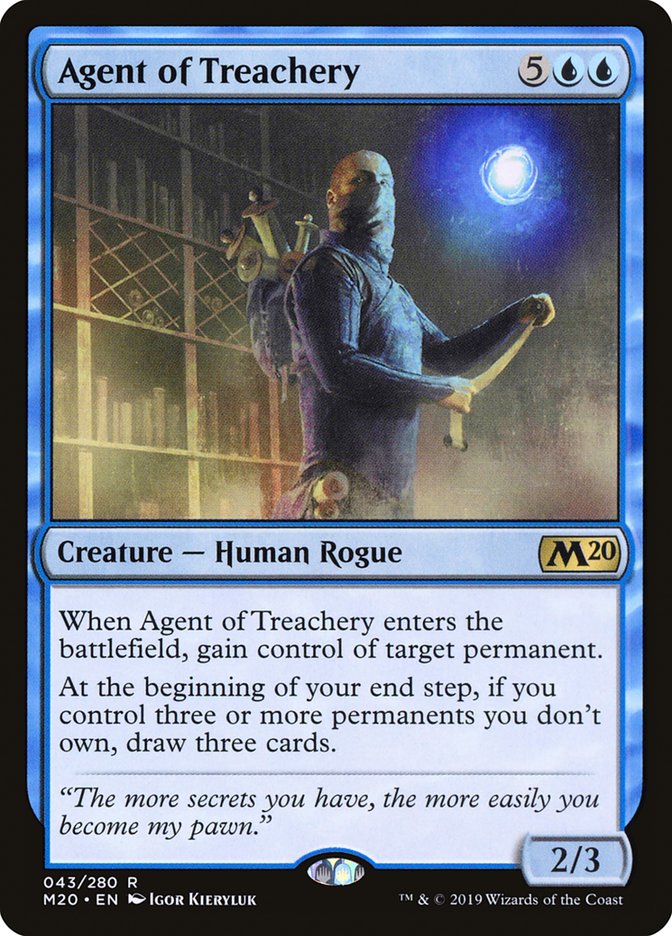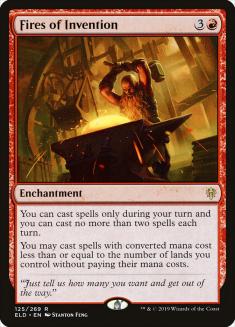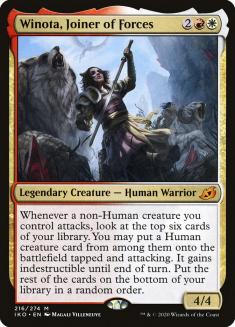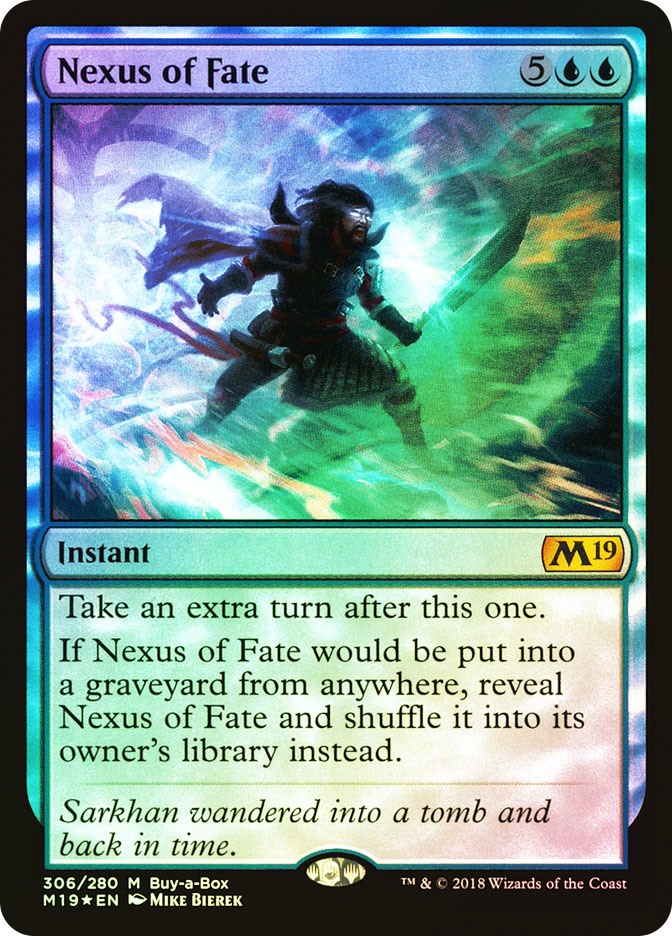Welcome to another edition of Fact or Fiction! Today, Bryan Gottlieb, Dom Harvey, Ross Merriam, and Shaheen Soorani are here to give their takes on five statements on the June 1st Banned & Restricted Announcement. Don’t forget to vote for the winner at the end!
1. Banning Agent of Treachery in Standard and Historic was a good decision.
Bryan Gottlieb: Fact. It’s hard to remember a card I’ve enjoyed playing with or against less than Agent of Treachery. There’s usually potential for interaction against a creature that has been cheated onto the battlefield. Oblivion Ring your Emrakul, the Aeons Torn. Swords to Plowshares your Griselbrand. The instances where you were able to overcome these massive threats made for an exciting story that took away some of the feel-bads from many, many losses.
Against an Agent of Treachery cheated onto the battlefield early, there was no real potential for a comeback. The problem was only exacerbated by the fact that Lukka, Coppercoat Outcast would often repeat the process on the next turn, and Yorion, Sky Nomad tripled and quadrupled down on the mana denial/ramp split card. Add in loops with Teferi, Time Raveler and it became laughable just how easy it was to snowball a game off a single Agent of Treachery.
The fact that this argument holds for both Standard and Historic shows just how far afield from acceptable this card is. If you had only taken out Fires of Invention, Winota, Joiner of Forces; The Cauldron of Eternity; Blood for Bones; and a host of other cards would have been all too happy to keep cheating Agent of Treachery onto the battlefield, and maybe Lukka would have just remained a top-tier competitor. Good riddance, and congratulations to Agent for becoming perhaps the least-hyped card upon release to find its way to the Banned List.
Dom Harvey: Fact, but misses the point. Agent of Treachery went from a seemingly innocuous rare to a quirky end-game trump for ramp decks to one of the most obnoxious cards Standard has seen in some time — and that bar is as high as it’s ever been. However, that trajectory highlights the real problem. Seven mana for one Agent is a fair price that prevents it from putting games out of reach early. Lukka setting up a chain of Agents from Turn 5 onwards or Winota finding fourteen mana of Agents on Turn 3 or 4 is an oppressive play pattern.
Historically, the cards that offer a substantial mana boost have been the problem — what you do with it is far less relevant. Nobody will shed any tears for Agent of Treachery, but a new tear-jerker is likely to emerge and prompt the same questions about Lukka or Winota before they leave Standard — maybe naturally, maybe before their time.
Ross Merriam: Fact. Cheating powerful, expensive permanents onto the battlefield much faster and at a much lower cost than intended has been a hallmark of powerful strategies in Magic ever since Spirit of the Night. The creatures we cheat have gotten much more powerful, and Agent of Treachery is the latest in that line.
Typically the card that gets banned is the one that enables the cheating, but in this case there are multiple enablers. Both Lukka, Coppercoat Outcast and Winota, Joiner of Forces have been used to great effect putting Agent of Treachery onto the battlefield, oftentimes multiple copies of the Agent, creating an unassailable advantage.
If the option was to ban Agent or both of the enabler cards, then banning Agent seems to be to be more prudent. Especially in the wake of the last few years, it’s important to ban the fewest cards possible to regain metagame diversity and high quality of gameplay.
Shaheen Soorani: Fact. There’s a terrible taboo against banning cards with high converted mana costs. The payoff being less problematic than the enabler has always been the accepted truth of competitive Magic. Outside of Emrakul, the Promised End, creatures that cost a ton have been safe from format removal. Agent of Treachery joins the club with a similar mana cost and format impact.
The cast trigger on the Eldrazi was game-ending, whereas the enters-the-battlefield trigger on Agent of Treachery has been heavily exploited. Both creatures would be fine at the end of the curve, but they tend to arrive to the battlefield much earlier than their mana cost indicates. Once they hit, the game moves out of reach, making them a must-answer before that. Hand disruption and counterspells are at an all-time weak point, not only in individual card strength but also the decks they exist in not being viable contenders. In order to put this seven-mana creature in the banning discussion, this perfect storm had to take place.
Banning Agent of Treachery was correct here for these reasons. Although this type of banning is unorthodox, Agent of Treachery provides painful gameplay that discourages the competitive population. Banning Winota, Joiner of Forces could be a temporary solution, but my guess is that additional enablers could be coming down the pike soon. Very few players will miss having all their permanents stolen and gameplay in Standard and Historic will improve.
2. Banning Fires of Invention in Standard and Historic was a good decision.
Bryan Gottlieb: Fact. Fires of Invention was never going to do anything good. The mana explosion it created is about as far as you can go without producing an infinite combo. The Magical Christmas Land application of Fires of Invention sees it come down as a free spell on Turn 4 and then gift you as much as ten additional mana on Turn 5. The problem with the pie-in-the-sky scenario is that it wasn’t actually rare at all, especially once companions hit the scene. The companion nerfs would have done only minimal damage to the most explosive Fires/Yorion turns.
Beyond this problem, Fires of Invention just isn’t a fun card to play. It takes away options from it caster, and screams “Just play your most expensive spell, stupid!” As mentioned in the Banned and Restricted announcement, the win rate for Fires decks has remained absurdly high for months, and the line identifying “risks and design constraints it poses to the environment going forwards” leads me to believe the deck was scheduled to get even more tools in the coming months.
Once again, there’s little need to differentiate between Standard and Historic. Fires of Invention is just that powerful, and even with Agent of Treachery leaving the format, a planeswalker-based Fires deck would have almost certainly been a top-tier threat.
Dom Harvey: Fact. The only surprise with this ban is that Fires lasted this long. If Oko, Thief of Crowns and Field of the Dead hadn’t stolen the spotlight, the clamour for a Fires ban would have been much louder much earlier. Jeskai Fires was a healthy-ish part of the metagame pre-Ikoria but could never stay that way for long — if companions hadn’t pushed it over the top, something else would have. Fires was never going to live its full life in Standard and the past few months proved why.
It’s a fun but difficult thought experiment to imagine a format where Fires is a healthy card. I worry that this ban is a necessary but insufficient distraction from the big-picture issues with the current design philosophy — when every card generates a considerable advantage and has to be matched or outmatched immediately, cheating on mana is that much more powerful. With Fires gone, that problem remains and it isn’t one you can sweep under the rug with just one ban.
Ross Merriam: Fact. Much has been made of the many ways to generate piles of extra mana that have been printed recently. Between Wilderness Reclamation; Nissa, Who Shakes the World; and Fires of Invention, the last couple of years have felt like making a boatload of mana so you can potentially ignore everything your opponent is doing should be the default strategy.
But of the three, Fires of Invention is the biggest offender. Wilderness Reclamation has a huge deckbuilding constraint: you can only take advantage of the mana on your end step. Its primary payoff card, Explosion, is also not particularly powerful without the Reclamation engine going.
Nissa, of the three, is the one that provides the least immediate payoff. You’re usually tapping out to cast it, and untapping one land recoups at most two of your five-mana investment. Maybe the 3/3 is relevant, but maybe it’s a liability, letting you lose a valuable land to Deafening Clarion or some other form of removal. This makes Nissa the easiest of the three to answer straight-up with a removal spell, or by attacking it. Attacking Nissa hasn’t been viable, since it has such high loyalty, but Elspeth Conquers Death has been great at answering it directly, largely driving Nissa out of the metagame.
Fires of Invention has none of these weaknesses. It can generate all of your initial four-mana investment back immediately, like Wilderness Reclamation, and places essentially no constraint on what spells you cast with it. People were casting Granted for Casualties of War in their Jeskai decks, for Pete’s sake. That’s not okay.
Shaheen Soorani: Fact. This was a banning that many of us knew was coming the moment it was previewed. Getting a free spell the turn you cast Fires of Invention, and then two free spells each of your turns for the rest of the game, will inevitably break healthy gameplay. The moment a reasonable combo entered Standard, it was seamlessly woven into a Fires of Invention deck that had all the power of a tap-out control deck already built in. This made combating the deck too difficult for the fast decks that were weak to sweepers and for the slower decks that were weak to planeswalkers.
Fires of Invention was only going to get more powerful over time, limiting future set design. Free spells seem to get banned at a much higher rate than others, which is what Fires of Invention enabled. The fundamental issues that continue to plague competitive Magic center on casting spells too early or for a discounted rate. Having essentially eight mana on Turn 4 and ten mana on Turn 5 is too good, regardless of the payoffs, and needed to be removed for the future format health of Standard and Historic.
3. Something else should have been banned in Standard.
Bryan Gottlieb: Fact. On last week’s Arena Decklists podcast, I made the case that eight cards should be banned. I was only half-joking. Teferi, Time Raveler; Yorion, Sky Nomad; Uro, Titan of Nature’s Wrath; Wilderness Reclamation; Cauldron Familiar; and Nissa Who Shakes the World could have all left the format and I wouldn’t have shed a single tear.
I have been forthright regarding my concerns with this Standard format. There are far too many decks and cards with unfun play patterns. The midrange slog-fests feel languid and unending when not defined by Agent of Treachery. While the companion shakeup means that most decks in the format have been altered, there is no question that the brunt of the impact is borne by the companions that are cheap or enable aggressive play styles. Yorion, Sky Nomad remains an incredibly good card after this change, whereas Lurrus of the Dream-Den and Obosh, the Preypiercer have seen their stock plummet.
At first blush, I expect these bans to leave a format with Jund Sacrifice, Temur Reclamation, Rakdos Sacrifice and Yorion Bant Control as the best decks. Is anyone thrilled to hop back into that world? We’ve done this already!
Maybe I live in a bubble designed to confirm my own beliefs, but it really felt like consensus was building that something was deeply, fundamentally wrong with the state of Standard. This was the opportunity for the folks at Wizards of the Coast (WotC) to have a frank conversation with the player base regarding what went wrong, and to reset the format to something exciting and new for us all to explore while the world crumbles around us. These bans just identified and fixed the singular problem of Yorion Jeskai Lukka. Plenty of other problems remain. I am still unenthused about jumping back into Standard.
Dom Harvey: Fact. But I can’t tell you what.
When Field of the Dead was banned, Oko took over. When Oko was banned, Fires took over. How confident can we really be that some new menace won’t emerge to force a Fact or Fiction on another ban update in the near future? If we have to rely on the broken cards to check each other, we will be locked in this pattern until something drastic changes. If we revert back to a Standard where Nissa, Who Shakes the World and Uro, Titan of Nature’s Wrath are the best cards again, is that a success? If Nissa is kept down by Wilderness Reclamation, are we meant to be cheering that instead?
Ross Merriam: Fact. I hate Teferi, Time Raveler. With a passion. I hate his stupid smug face whenever I draw counterspells and I hate that stupid energy ball in his hand. We get it, you’re a wizard. It’s not that deep.
I look at what Standard has become, a format overrun by what are essentially big mana strategies, and it seems clear to me that the best answer is to play a tempo strategy with plenty of counterspells. These decks historically crush big mana but are relatively weak to aggro, and thus create a natural metagame progression.
But when their best matchups get to play four copies of Teferi in the maindeck, and four copies of Mystical Dispute in the sideboard to protect it, there just isn’t much you can do besides hope your draw lines up perfectly.
The problem with Teferi arises because it’s an incredibly powerful hate card against certain strategies, one that is generically powerful and flexible enough to maindeck and not lose ground against anything else. Its power to suppress counterspells has played a huge part in creating the big mana dominated metagame we’ve seen today, and I’m ready to see it go, even if it only has a few months remaining in Standard anyway.
Shaheen Soorani: Fiction. I am never shy about advocating for cards that need to be banned in order to preserve format health. This applies to cards that fit my favorite decks especially, as one of my previous articles demands the removal of Arcum’s Astrolabe and Mishra’s Bauble from Modern. There is no better game in the world when the formats are healthy and creating that environment is one of my top priorities as a content creator.
There is one card that has received some hate over the last few months, and removing it will not benefit Standard at all.
Teferi, Time Raveler is not the most popular card for some people, but it does keep control and midrange decks afloat in Standard. Removing it would cripple the slower archetypes and stifle the diversity that this new metagame is about to produce. I do not think it will ever be banned, but it is on the cusp from a power level perspective. Just because a card is good does not mean it has to go. The loyalty is manageable and aggro decks can push past it, making it fine for the format. Outside of Teferi, Time Raveler, most folks I have interacted with are content with what was removed.
4. Something else should have been banned in Historic.
Bryan Gottlieb: Fact. Winota, Joiner of Forces is Aetherworks Marvel in creature form. Since Naya Winota uses Angrath’s Marauders as its kill, the deck is untouched by the Agent of Treachery ban. Much like Aetherworks Marvel, I do not care what the win rate is for this deck. It can potentially win on Turn 3 and is miserable to play with and against. The problem will only get worse with subsequent prints. Do you want Turbo Fog decks? Because this is how you get Turbo Fog decks! Ban Winota.
Dom Harvey: Fact. Agent of Treachery was suspended in Historic “for similar reasons” as Standard — namely, Lukka and Winota. The best deck in Historic was Naya Winota and removing Agent doesn’t hurt it whatsoever. If WotC wants players to take Historic seriously, these decisions will require an explanation that actually references Historic, is more than one sentence long, and doesn’t miss the target altogether.
Ross Merriam: Fact. Admittedly, I haven’t played much Historic, but the deck everyone has hyped to me and looks very overpowered is Naya Winota, and neither ban touches that deck. It’s fast, it’s powerful, and it’s not completely reliant on Winota to win the game, since the quality of the cheap creatures in Historic is much greater than in Standard.
I was also left entirely unsatisfied by WotC’s explanation of the Historic bans, since all we got was a bland “for similar reasons” to Standard sidestep. Historic is a different format from Standard with a different metagame.
Naya Winota is very straightforward, and thus easy to determine how to attack, so maybe they are confident that the metagame can adapt, but to not mention it at all was puzzling.
Shaheen Soorani: Fiction. The horror of Fires of Invention and Agent of Treachery will finally pass, making Historic a brand-new place for innovation. The format was fun before these decks took over and I expect the enjoyment to return. Aggro, midrange, and control are all viable, having access to some of the top players that each archetype utilized over the last few years. I, for one, will be happily casting Teferi, Hero of Dominaria once again.
Without any major event in Historic, it is tough to judge what else should have been removed from the format. With the amount of legal sets, it is likely that something else will have to go; however, it is impossible to make an informed decision at this point. There are premier events coming down the pike in Historic and that will allow us to see what the best and brightest bring to the table, as everyone tries to break it to achieve glory. I look forward to seeing what the pros bring to the table, as well as cast my favorite Esper Control cards to defeat them!
5. The Companion Rule change is a good one.
Bryan Gottlieb: Fiction. Look, there just wasn’t a solution here that would have gotten a “Fact” from me. No matter the fix, it was going to be inelegant. I do think this solution should limit the ubiquity of companions in Eternal formats — an important aspect of mitigating the problem. However, I am extremely concerned about how uneven this fix is across individual companions in Standard.
As I mentioned previously, companions that skew aggressive and require being cast on-curve take huge hits. Meanwhile, Yorion, already the best companion in Standard, can bear the extra cost far more gracefully. Something like a mulligan requirement may have done a better job keeping aggressive companions viable, but honestly, Yorion’s ability to generate card advantage would have overcome that hurdle far more successfully as well. It wouldn’t surprise me if we’re back here in a few months addressing Yorion specifically.
I get that just giving up on the flagship mechanic of an entire set wasn’t a realistic option given the need to sell Magic cards, so I guess I’m not overly disappointed that companions remain part of the game. I’m just… tired? Maybe that’s worse.
Dom Harvey: Fiction.
The new rule addresses the dominance of companion but its impact is highly uneven. Companions that belong in fast, linear decks are significantly weakened by this rule while Yorion, Sky Nomad remains a useful end-game tactic. Decks that made major sacrifices to adopt a companion now have to reevaluate, while the aggressive strategies that got to freeroll Lurrus of the Dream-Den can still do that. Forcing those decks to take a turn finding their companion gives opponents some much-needed breathing room, but an extra card that draws extra cards will always be strong as long as it’s realistically castable.
Ross Merriam: Fiction. When I read the announcement of the companion change, I was just confused. This is a cumbersome, clunky change on the surface, and I don’t see how it accomplishes balancing companions as a whole.
The power of companions comes from how easy it is to gain an extra card. And not just any card, but a powerful one that you can build your deck to utilize to its fullest. The easiest nerf is to stop it from being an extra card. Various fixes to this end were suggested by community members, but I guess they’re committed to making companion an effective eighth card. Adding mana to the cost of accessing the card does make it less powerful, but you’re introducing a new variable into the equation with the cost. Is it too high? Too low? If companions stop seeing play, will you lower the cost? If they are still dominant, will you raise it? Ultimately, I don’t see preserving companions as an effective eighth card to be worth adding these questions down the line.
But what I hate most about this change is that it favors companions that fit into midrange strategies that are best equipped to pay the extra cost. Lurrus of the Dream-Den and Obosh, the Preypiercer decks are hurt immensely by this change, and while Yorion, Sky Nomad is hurt to a degree, it’s much less than the cheaper cards. Yorion was already the bigger issue in Standard and Historic. It’s been closer in Pioneer and Modern, with an edge to Lurrus.
The point of the additional cost is to reduce repetitive gameplay by incentivizing players to cast cards from their hand before they use their companion, but that’s already what Yorion decks do. There’s often an extra turn between casting it, which is nice, but it doesn’t fundamentally alter how these decks play out. But it does fundamentally alter how Lurrus and Obosh decks play out, because they rely on curving out and that’s now impossible. You can’t just take Turn 3 off in your aggro deck.
My only hope for this change is that it weakens companions to the point where they see no play, and that sucks, because they are fun in small doses. But the alternative is that midrange decks gain a huge advantage over the rest of the metagame.
Shaheen Soorani: Fact…for now. I am cautiously optimistic about the rule change in Standard. The new Companion Rule will completely level the playing field in older formats, as three generic mana is a steep cost there. There are few times where decks will have the ability to break a companion early on, since it will require taking a whole turn off in the early-game. I do worry about future companions and if their requirement will be too easy to pull off. That could negatively impact older formats, but we cannot be certain what the future holds in Play Design. At this point, two companions will still see significant play across the formats.
Lurrus of the Dream-Den and Yorion, Sky Nomad will still see play due to their generous restrictions. We have all learned that 80-card decks are just fine and aggro decks do not mind playing all one- and two-mana permanents. This is fine because the new Companion Rule makes it powerful, but not oppressive. There is a real cost attached beyond the deck restrictions, making this a smart fix for the time being.










